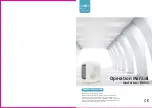
69
Fig. 84 — Zone CO2 Setpoint Screen
To change the CO
2
setpoint:
1. Press
ENTER
to change the value. The screen softkeys will
appear which will allow the value to be changed.
2. Click the
[
INCR]
or
[
DECR]
softkeys to change the
value.
3. To save the change, press the
[
OK]
softkey. To cancel the
change, press the
[
CANCEL]
softkey.
SERVICE
Compressor Rotation
To determine whether or not the compressor is rotating in the
proper direction:
1. Connect service gages to suction and discharge pressure
fittings.
2. Energize the compressor.
The suction pressure should drop and the discharge pressure
should rise, as is normal on any start-up. If the suction pres-
sure does not drop and the discharge pressure does not rise to
normal levels:
3. Turn off power to the unit and tag disconnect.
4. Reverse any 2 of the unit power leads.
Reapply power to the unit. The suction and discharge pres-
sure levels should now move to their normal start-up levels.
Also, check that the fan is rotating in the proper direction.
Incorrect wiring can lead to improper phase sequence resulting in
scroll compressor failure due to reverse rotation. Signs of reverse
rotation include:
• Excessive noise
• Reverse rotation of 3 phase indoor fan
• Rapid temperature rise on suction tube
• No pressure differential
• No cooling
Correct immediately. Shut off power at disconnect and switch any
2 power leads at unit terminal block or pigtails.
Fan Motor Replacement
If required, replace the fan motor with an equal or better type and
efficiency motor with equal horsepower. The motor must be rated
for a VFD or inverter application. Do not change the horsepower
unless there is a system design requirement change and VFD size
analysis.
CHECK/CHANGE VFD OUTPUT CURRENT LIMIT
The VFD provides additional fan motor protection by limiting
the output current to a programmed value. This value has been
factory set according to the factory-installed motor and VFD siz-
ing options.
If the VFD and/or motor is replaced, the VFD setup mode param-
eter "tHr1" should be reprogrammed to the following calculated
values for optimum motor protection and operating range:
For VFD size about equal to motor:
tHr1 = 100*motor nameplate Amps / VFD rated output Amps
MAINTENANCE
Cleaning Unit Exterior
Unit exterior panels should be wiped down using a damp soft
cloth or sponge with a mixture of warm water and a mild
detergent.
Coil Cleaning
Hot water, steam, and direct expansion coils must be cleaned at
least once a year to maintain peak performance. Dirty coils can
contribute to decreased heating or cooling capacity and efficien-
cy, increased operating costs, and compressor problems on direct
expansion systems. Dirt, grease, and other oils can also reduce
the wettability of the coil surfaces, which can result in moisture
blow-off from cooling coils and resulting water leakage prob-
lems. If the grime on the surface of the coils becomes wet, which
commonly occurs with cooling coils, microbial growth (mold)
can result, causing foul odors and health-related indoor air quali-
ty problems.
Coils can become dirty over a period of time, especially if air filter
maintenance is neglected. Coils should be inspected regularly and
cleaned when necessary. Clean coils with a vacuum cleaner, fresh
water, compressed air, or a bristle brush (not wire). Do
not
use
high-pressure water or air—damage to fins may result. Backflush
coil to remove debris. Commercial coil cleaners may also be used
to help remove grease and dirt. Steam cleaning is NOT recom-
mended. After cleaning, use a fin comb of the correct fin spacing
when straightening mashed or bent coil fins.
Units installed in corrosive environments should be cleaned as
part of a planned maintenance schedule. In this type of applica-
tion, all accumulations of dirt should be cleaned off the coil.
Inspection
Check coil baffles for tight fit to prevent air from bypassing the
coil. Check panels for air leakage, particularly those sealing the
fan and coil compartments. Check for loose electrical connections,
compressor oil levels, proper refrigerant charge, and refrigerant
piping leaks. Before start-up, be sure all optional service valves
are open.
Air Filters
The 50BV single-piece units come with 1-in. filters. The standard
1-in. filters provide lower pressure drop and longer filter service
intervals. The 50BV modular units come with 4-in. filters.
Inspect air filters every 30 days and replace filters as necessary.
Replacement filters should have a minimum efficiency rating of
MERV 6 per ASHRAE rating procedures and be rated for up to
625 fpm velocity. Job requirements or local codes may specify
higher minimum ratings.
CAUTION
Improper phase sequence will cause scroll compressor
failure due to reverse rotation.
















































